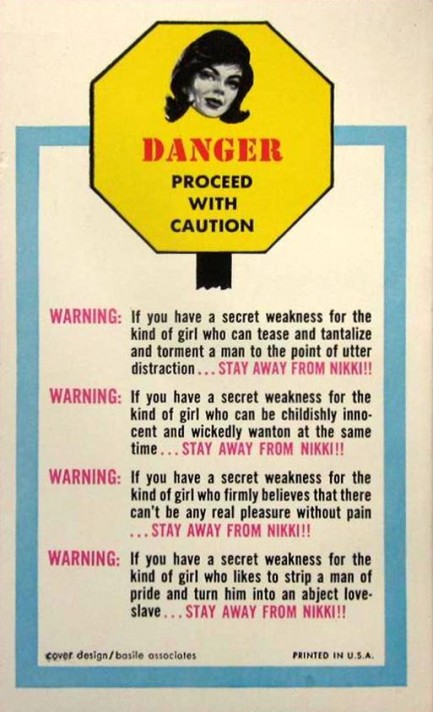| Vintage Pulp | Mar 22 2024 |

This ain't Happy Days and he ain't the Fonz.
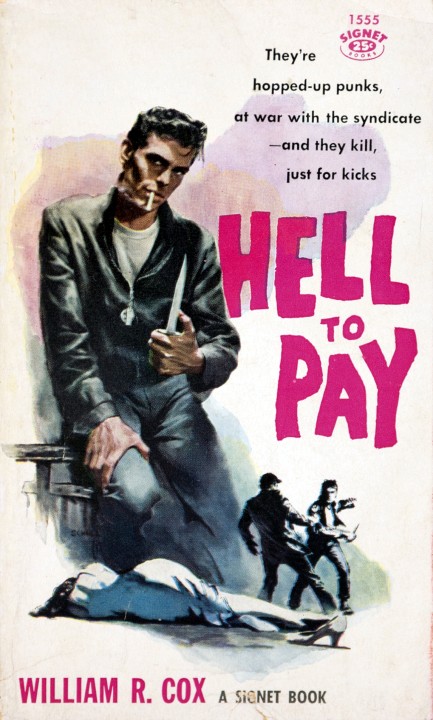
Since reading William R. Cox's 1961 thriller Death Comes Early we'd been looking around for more from him and located 1958's Hell To Pay, which you see above with a Robert Schulz cover. Cox writes in that same cool style we noted before, as he combines two crime sub-genres—organized crime, and juvenile delinquency. His main character Tom Kincaid is a successful NYC gambler who gets swept up in a mafia takeover centered around crooked boxing. Kincaid is thought by a kingpin named Mosski to be working for an upstart mob, which essentially makes this a find-the-real-killer novel in the sense that if Kincaid can't prove he isn't setting up Mosski his ass is grass. The book has in abundance generation gap musings, shady mingling between criminals and cops, poker described in hand-by-hand detail, and a lot of shooting and/or brutal beatings. Cox provides several good secondary characters, particularly Kincaid's been-around-the-block girlfriend Jean Harper. She's flawed, but then so is everyone here. There's a sequel to Hell To Pay, and we're onto that already.

| Vintage Pulp | Mar 22 2022 |

Hemingway scales the literary heights by plumbing human depths.

The great film director John Huston once made an interesting observation about Ernest Hemingway. He said Hemingway had fallen out of fashion because he wrote about courage. Huston didn't mean courage like Liam Neeson facing a pack of wolves or a terrorist. He meant the willingness to face temporality and mortality, and accept them for what they are. He meant the willingness to try to achieve things of great personal value while realizing none of them would last, and none of them truly mattered. The cultural trend has always been to tell people they're special and what they think and do matters and will last. But Hemingway considers that a conceit. 99.99999% of people are simply forgotten. The things they did are forgotten too.
This has happened to the most famous people of their eras. Name a U.S. governor who was in office during the Civil War. Name the wealthiest landowner of imperial Rome. They probably never imagined they'd be forgotten. Human temporality and mortality, set against the backdrop of nature or conflict, is Hemingway's thing. Nihilistic themes date from the earliest literature, but Hemingway, in projecting these ideas through a modern, almost pop culture lens, spoke for generations who had experienced two of the largest and deadliest wars in human history—we're talking well over 100 million dead. Hemingway was wounded in Italy in 1918. George Orwell was shot through the throat in Spain in 1937 during a precursor conflict to World War II. Erich Maria Remarque sustained multiple wounds in World War I. Imagine literature without them.
100 million war dead, among them writers who never wrote, painters who never painted, inventors who never invented. The world lost untold human capital, immeasurable progress. The literary public was ready for authors to tackle the senselessness of warfare. The between-wars period, encompassing a flu pandemic that killed 50 million, followed by the Great Depression, was likewise a wellspring of disillusionment. All these upheavals made clear that everything hangs by the barest thread. That level of suffering is unknown in the U.S. today, a country that has had its constant warfare sanitized for easy consumption, and that's really why Hemingway is out of favor—because his themes are almost alien to an American public that has forgotten what it means to suffer on a mass scale.
But while it's been fashionable for the last forty or so years to bash Hemingway, it's a self defeating exercise. We think what people usually mean to bash is his stature, or his out-of-date attitudes, which are understandable criticisms. However, to say he's a bad writer is to make oneself look ridiculous. We've said a few times before, and we'll say again here, that a good writer teaches you how to read their work. It's similar to the idea of willing suspension of disbelief in cinema. You accept the premise, or don't bother watching the film in the first place. It's okay to dislike a book as long as you try to read it on the terms the author asks. Otherwise, why bother? You read an adventure author on his or her terms, a mystery author on their terms, and a sleaze author on their terms. And certainly, you read a literary author on their terms.
None of this is to say Hemingway didn't have flaws, particularly when viewed trough a modern social lens. At Pulp, we tend to view writers as content producers first. For example, we pointed out recently that Camilo José Cela was a fascist. We personally are the opposite. But Cela still could write. Seeking enrichment only from ethically pure artists makes for a meager diet, and ethical purists should be forewarned—though modern judgments are necessary tools for measuring our progress, judgments come down the pike for everyone eventually. Legions of twenty-somethings who think they're pristine will one day be blamed for enabling slavery because they used smartphones dependent upon forced labor in African cobalt mines. Ethics evolve, and generational judgment comes for all.
Green Hills of Africa, originally published in 1935, with the Perma Books edition you see above coming in 1956 with Robert Schulz cover art, is autobiographical. A thirty-six year old Hemingway goes on safari mainly in Tanzania, and sets his personal goals against vast and indifferent wilds. By design nothing important seems to happen, but through his descriptive powers he brings Africa to the fore, and makes himself a bit player, just an ant on the endless landscape. The narrative could be shorter and more focused, but even as it rambles the same way Hemingway rambles across the dry plains, his wide ranging hunt for kudu, rhino, and lion assumes an almighty personal importance. His desire draws you in. His many small triumphs and failures become increasingly gripping, and sharpen the irony of his own impermanence and the impermanence of his acts.
But as we've mentioned before, Hemingway and his ilk operated under an earlier—and mistaken—ecological understanding. Our acts actually do matter, not because we're individually important, but in the accumulation of our billions of tiny effects. Hemingway assumed humans had no meaningful impact on nature. Now we know that's only half true—we're impossibly insignificant and incredibly impactful. We're tiny animalcules that have heedlessly wrecked a vast ecosystem. Green Hills of Africa is like a work of high fantasy, taking place in a reality that never truly existed. Despite its mistaken assumption, it does exactly what Hemingway wanted—says that nature is implacable, while human acts, achievements, and loves are comically impermanent. That was his message, a message people were ready to hear. That was Hemingway.
But as we've mentioned before, Hemingway and his ilk operated under an earlier—and mistaken—ecological understanding. Our acts actually do matter, not because we're individually important, but in the accumulation of our billions of tiny effects. Hemingway assumed humans had no meaningful impact on nature. Now we know that's only half true—we're impossibly insignificant and incredibly impactful. We're tiny animalcules that have heedlessly wrecked a vast ecosystem. Green Hills of Africa is like a work of high fantasy, taking place in a reality that never truly existed. Despite its mistaken assumption, it does exactly what Hemingway wanted—says that nature is implacable, while human acts, achievements, and loves are comically impermanent. That was his message, a message people were ready to hear. That was Hemingway.
| Vintage Pulp | Oct 26 2020 |

Bad news. Your husband refused to pay the ransom. He also wanted me to tell you it's not you, it's him.
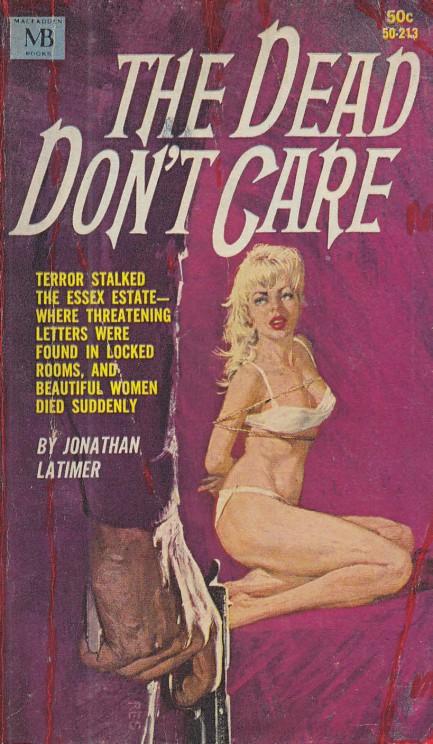
A while back we moved Jonathan Latimer from the decent bin to the mandatory bin off the back of his crazy thriller Solomon's Vineyard. We're returning him to the decent bin. The Dead Don't Care is an okay book, but not top notch. Latimer wrote it in 1938, and it was the fourth entry in a detective franchise starring a boozy dick named Bill Crane, and an equally boozy sidekick named Thomas O'Malley. The two engage in such shenanigans as ordering double-triple bourbons and generally pickling their livers at every opportunity—which we totally respect‚ but the actual mystery, divorced from its comedic elements, is overly talky and populated by characters that tend to blend after a while.
Basically, Crane and O'Malley are called in when an upper crust woman is kidnapped, and someone is murdered. As usual in such books, the first murder isn't the last, and the second killing provides key clues to finally unmasking the eventual culprit. In all, it was meh. But it did well enough to spawn a film adaptation, 1938's The Last Warning, which we may watch at some point. We're in no way discouraged by The Dead Don't Care. We already know Latimer can write. But it isn't surprising he'd run into problems four entries into a series that would peter out after one more outing. We'll move on to his other books and do so eagerly. This MacFadden-Bartell paperback came in 1964, and the cover art is by Robert Schulz.
| Vintage Pulp | Dec 12 2016 |

Go completely unnoticed in any setting with the amazing new Undercover Operative Trench Coat.
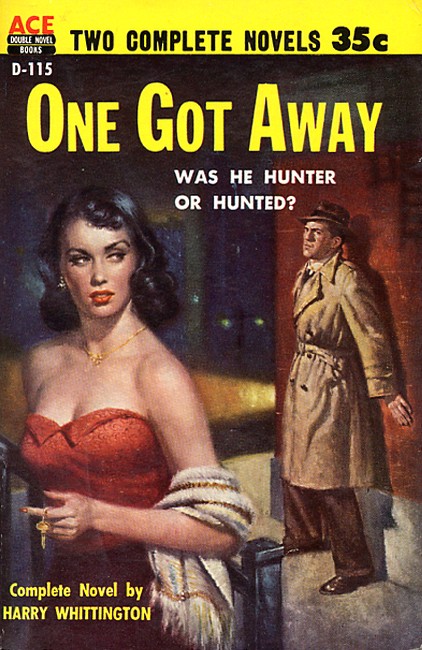
Well, some products don't work as advertised. We weren't going to buy it, but then we learned it came with a complimentary limited edition newspaper with two eye holes cut in it. But when we wore the coat we got spotted immediately and now we have a restraining order. 1955 copyright on this Ace Double of Harry Whittington's One Got Away (Robert Schulz cover art), bound with Cleve F. Adams' Shady Lady (Harry Barton on the art chores). We'll see you after our probation hearing.
| Vintage Pulp | Sep 17 2014 |

Part angel, part goddess, and part alley cat.
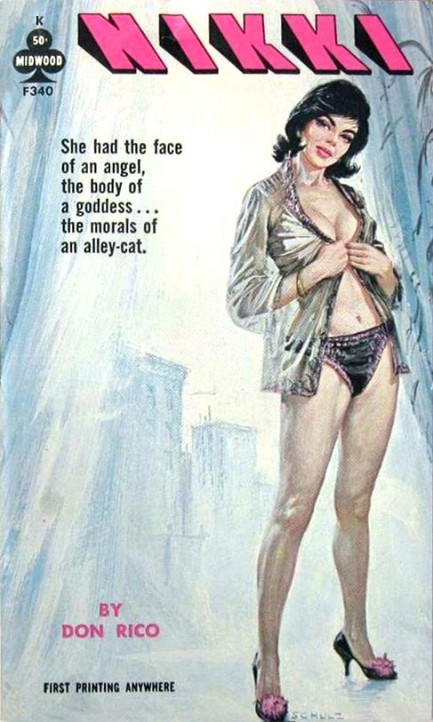
Seems like one good Midwood deserves another, so here’s another effort from them—Don Rico’s Nikki, published in 1963. After years writing for comics, this was Rico’s first novel, and he would later publish other books as Dan Rico, Donella St. Michaels, Donna Richards, Joseph Milton, et al. The back cover text for Nikki is unusually entertaining, so we’ve got that below as well. The excellent art is the work of Robert Schulz.
